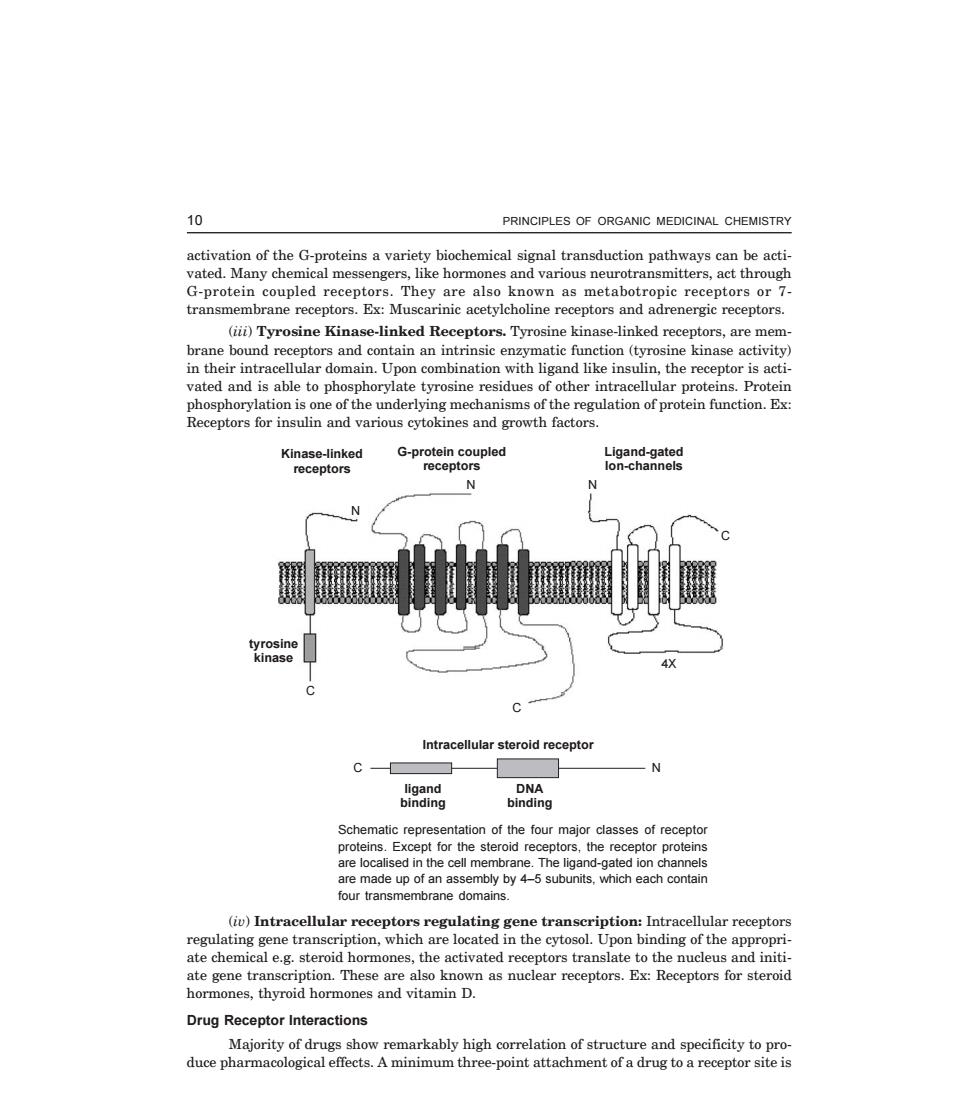正在加载图片...

10 PRINCIPLES OF ORGANIC MEDICINAL CHEMISTRY activation of the G-proteins a variety biochemical signal transduction pathways can be acti. vated.Many chemical messengers,like hormones and various neurotransmitters,act through G-protein coupled receptors.They are also known as metabotropic receptors or 7- transmembrane receptors.Ex:Muscarinic acetylcholine receptors and adrenergic receptors. (iii)Tyrosine Kinase-linked Receptors.Tyrosine kinase-linked receptors.are mem brane bound ceptors and contain an intrinsic enz matic function (tyrosine kinase activity) in their intracellular domain.Upon combination with ligand like insulin,the receptor is acti- vated and is able to phosphorylate tyrosine residues of other intracellular proteins.Protein phosphorylation is one of the underlying mechanisms of the regulation of protein function.Ex: Receptors for insulin and various cytokines and growth factors. Kinase-linked G-protein coupled receptors Intracellular steroid receptor C -N DNA binding Sch representation of the four majo for the are localised in the cell membrane.The ligand-gated on channels are made up of an assembly by 4-5 subunits,which each contain four transmembrane domains ()gene transeription:Intracellular receptor regulating gene transcription.which are located in the binding of the a nr ate chemical e.g.steroid hormones.the activated receptors translate to the nucleus and initi ate gene transcription.These are also known as nuclear receptors.Ex:Receptors for steroid hormones,thyroid hormones and vitamin D. Drug Receptor Interactions duce ph ee-point 10 PRINCIPLES OF ORGANIC MEDICINAL CHEMISTRY C-8—N-CHEMI\CHE2-1.PM5 activation of the G-proteins a variety biochemical signal transduction pathways can be activated. Many chemical messengers, like hormones and various neurotransmitters, act through G-protein coupled receptors. They are also known as metabotropic receptors or 7- transmembrane receptors. Ex: Muscarinic acetylcholine receptors and adrenergic receptors. (iii) Tyrosine Kinase-linked Receptors. Tyrosine kinase-linked receptors, are membrane bound receptors and contain an intrinsic enzymatic function (tyrosine kinase activity) in their intracellular domain. Upon combination with ligand like insulin, the receptor is activated and is able to phosphorylate tyrosine residues of other intracellular proteins. Protein phosphorylation is one of the underlying mechanisms of the regulation of protein function. Ex: Receptors for insulin and various cytokines and growth factors. N N Kinase-linked receptors G-protein coupled receptors Ligand-gated Ion-channels N C C C 4X tyrosine kinase Intracellular steroid receptor ligand binding DNA binding C N Schematic representation of the four major classes of receptor proteins. Except for the steroid receptors, the receptor proteins are localised in the cell membrane. The ligand-gated ion channels are made up of an assembly by 4–5 subunits, which each contain four transmembrane domains. (iv) Intracellular receptors regulating gene transcription: Intracellular receptors regulating gene transcription, which are located in the cytosol. Upon binding of the appropriate chemical e.g. steroid hormones, the activated receptors translate to the nucleus and initiate gene transcription. These are also known as nuclear receptors. Ex: Receptors for steroid hormones, thyroid hormones and vitamin D. Drug Receptor Interactions Majority of drugs show remarkably high correlation of structure and specificity to produce pharmacological effects. A minimum three-point attachment of a drug to a receptor site is